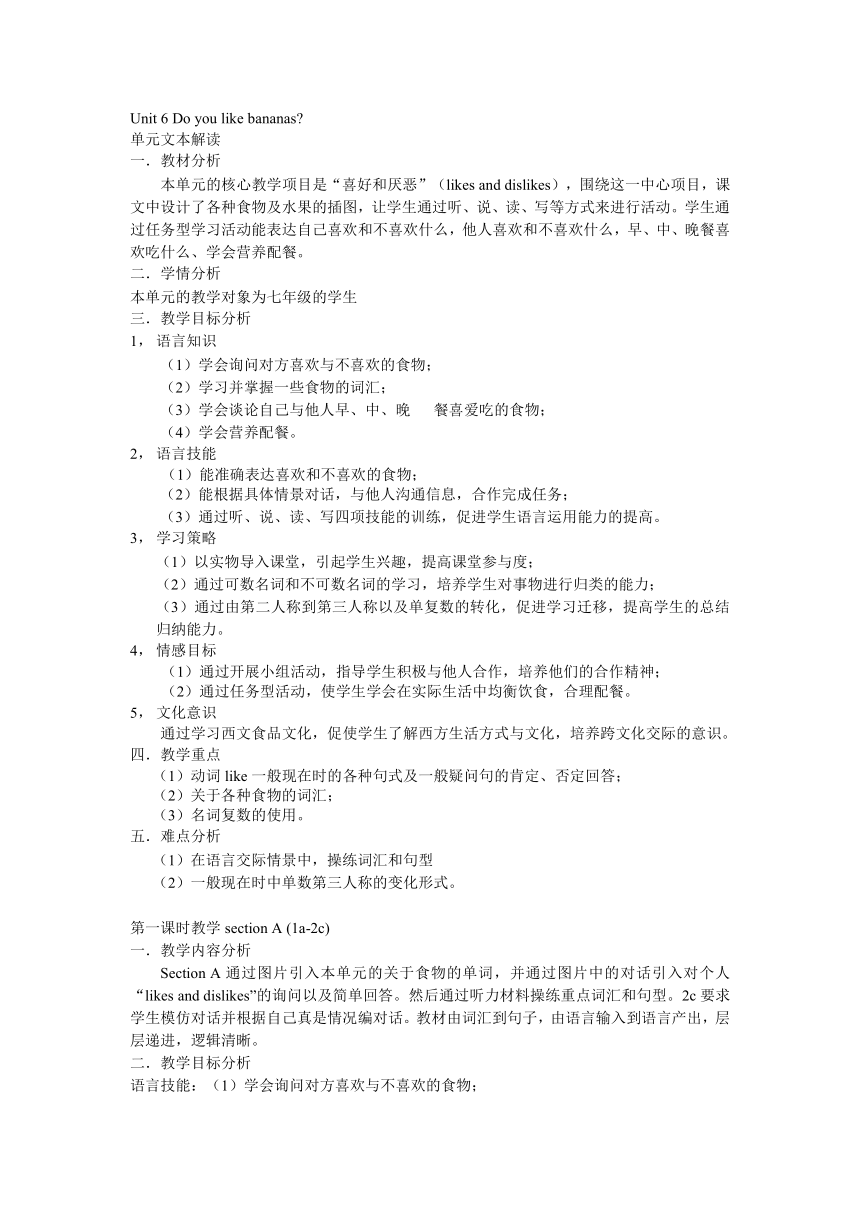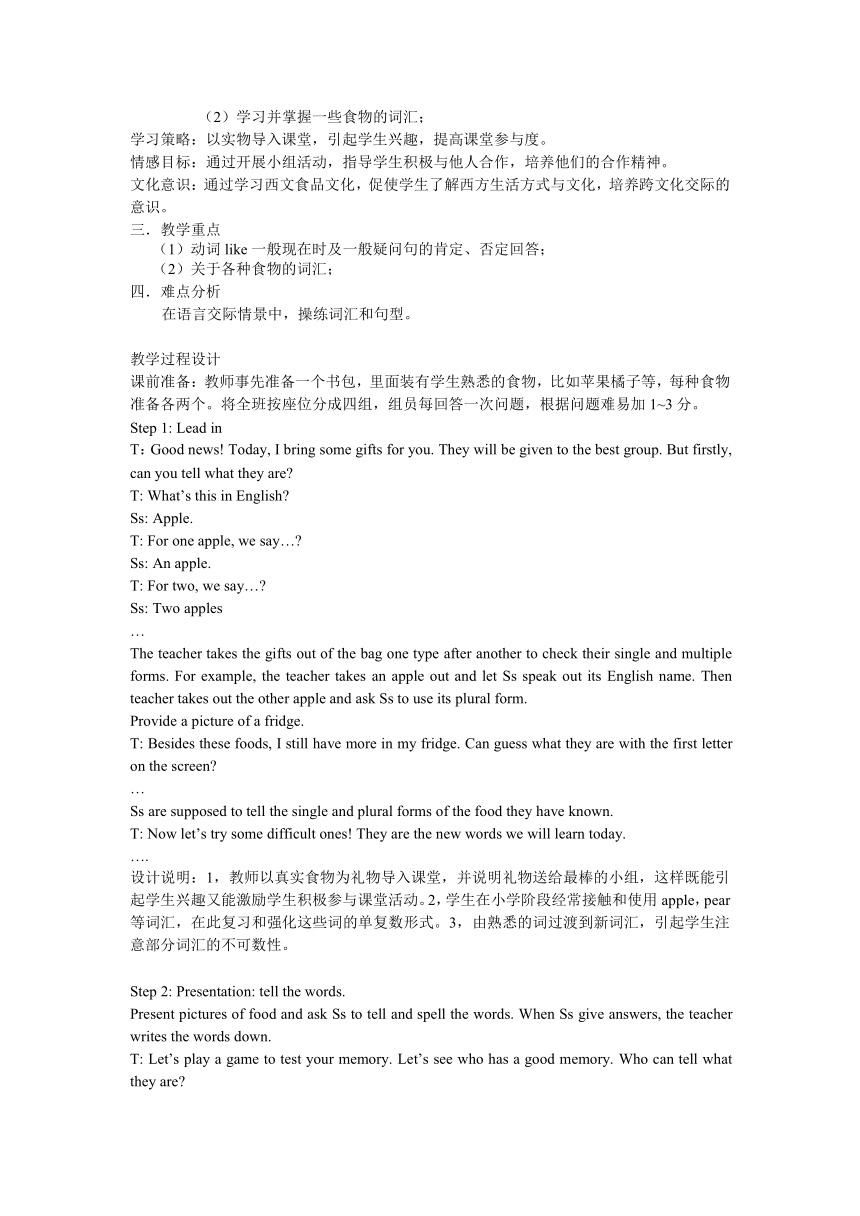unit6 Do you like bananas说课教案、单元计划
文档属性
| 名称 | unit6 Do you like bananas说课教案、单元计划 |  | |
| 格式 | zip | ||
| 文件大小 | 16.6KB | ||
| 资源类型 | 教案 | ||
| 版本资源 | 人教新目标(Go for it)版 | ||
| 科目 | 英语 | ||
| 更新时间 | 2012-10-27 10:28:26 | ||
图片预览


文档简介
Unit 6 Do you like bananas?
单元文本解读
教材分析
本单元的核心教学项目是“喜好和厌恶”(likes and dislikes),围绕这一中心项目,课文中设计了各种食物及水果的插图,让学生通过听、说、读、写等方式来进行活动。学生通过任务型学习活动能表达自己喜欢和不喜欢什么,他人喜欢和不喜欢什么,早、中、晚餐喜欢吃什么、学会营养配餐。
学情分析
本单元的教学对象为七年级的学生
教学目标分析
语言知识
(1)学会询问对方喜欢与不喜欢的食物;
(2)学习并掌握一些食物的词汇;
(3)学会谈论自己与他人早、中、晚 餐喜爱吃的食物;
(4)学会营养配餐。
语言技能
(1)能准确表达喜欢和不喜欢的食物;
(2)能根据具体情景对话,与他人沟通信息,合作完成任务;
(3)通过听、说、读、写四项技能的训练,促进学生语言运用能力的提高。
学习策略
(1)以实物导入课堂,引起学生兴趣,提高课堂参与度;
(2)通过可数名词和不可数名词的学习,培养学生对事物进行归类的能力;
(3)通过由第二人称到第三人称以及单复数的转化,促进学习迁移,提高学生的总结归纳能力。
情感目标
(1)通过开展小组活动,指导学生积极与他人合作,培养他们的合作精神;
(2)通过任务型活动,使学生学会在实际生活中均衡饮食,合理配餐。
文化意识
通过学习西文食品文化,促使学生了解西方生活方式与文化,培养跨文化交际的意识。
教学重点
(1)动词like一般现在时的各种句式及一般疑问句的肯定、否定回答;
(2)关于各种食物的词汇;
(3)名词复数的使用。
难点分析
(1)在语言交际情景中,操练词汇和句型
(2)一般现在时中单数第三人称的变化形式。
第一课时教学section A (1a-2c)
一.教学内容分析
Section A通过图片引入本单元的关于食物的单词,并通过图片中的对话引入对个人“likes and dislikes”的询问以及简单回答。然后通过听力材料操练重点词汇和句型。2c要求学生模仿对话并根据自己真是情况编对话。教材由词汇到句子,由语言输入到语言产出,层层递进,逻辑清晰。
二.教学目标分析
语言技能:(1)学会询问对方喜欢与不喜欢的食物;
(2)学习并掌握一些食物的词汇;
学习策略:以实物导入课堂,引起学生兴趣,提高课堂参与度。
情感目标:通过开展小组活动,指导学生积极与他人合作,培养他们的合作精神。
文化意识:通过学习西文食品文化,促使学生了解西方生活方式与文化,培养跨文化交际的意识。
三.教学重点
(1)动词like一般现在时及一般疑问句的肯定、否定回答;
(2)关于各种食物的词汇;
四.难点分析
在语言交际情景中,操练词汇和句型。
教学过程设计
课前准备:教师事先准备一个书包,里面装有学生熟悉的食物,比如苹果橘子等,每种食物准备各两个。将全班按座位分成四组,组员每回答一次问题,根据问题难易加1~3分。
Step 1: Lead in
T:Good news! Today, I bring some gifts for you. They will be given to the best group. But firstly, can you tell what they are?
T: What’s this in English?
Ss: Apple.
T: For one apple, we say…?
Ss: An apple.
T: For two, we say…?
Ss: Two apples
…
The teacher takes the gifts out of the bag one type after another to check their single and multiple forms. For example, the teacher takes an apple out and let Ss speak out its English name. Then teacher takes out the other apple and ask Ss to use its plural form.
Provide a picture of a fridge.
T: Besides these foods, I still have more in my fridge. Can guess what they are with the first letter on the screen?
…
Ss are supposed to tell the single and plural forms of the food they have known.
T: Now let’s try some difficult ones! They are the new words we will learn today.
….
设计说明:1,教师以真实食物为礼物导入课堂,并说明礼物送给最棒的小组,这样既能引起学生兴趣又能激励学生积极参与课堂活动。2,学生在小学阶段经常接触和使用apple,pear等词汇,在此复习和强化这些词的单复数形式。3,由熟悉的词过渡到新词汇,引起学生注意部分词汇的不可数性。
Step 2: Presentation: tell the words.
Present pictures of food and ask Ss to tell and spell the words. When Ss give answers, the teacher writes the words down.
T: Let’s play a game to test your memory. Let’s see who has a good memory. Who can tell what they are?
S1: Ice-cream
T: How to spell it in English?
S1: I-C-E-C-R-E-A-M.
S2: Bread. B_R_E_A_D.
S3…
设计说明:通过游戏形式进一步巩固词汇记忆,既激发学生学习兴趣,又能充分利用上课时间,提高学习效率。
Step 3: Listen and practice.
Do 1a ,1b and 1c. Write the sentence pattern on the bb. Read the conversation. Practice the target sentence pattern and its answers.
T: Do you like salad?
S1: Yes, I do. / No, I don’t.
T: Do you like hamburgers?
S2: Yes, I do. / No, I don’t.
…
After asking students, let students do a pair work with the sentence pattern.
设计说明:本部分是新词汇到新句型的过渡, 在巩固新词汇的基础上学习新句型,并且有听到说,逐步掌握新知识。另外,这部分也是听说技能的训练。
Step 4: Listen and practice.
Listen to 2a and 2b. Pay attention to sentence pattern “Do you like…?” “Yes, I do.” “No, I don’t. / No, I don’t like…”. Add “No, I don’t like …” on the bb.
设计说明:这部分教学内容是对上部分的加深和加强。一方面,学生通过听对话获取单词补全对话,对本节课的重要单词进行了复习。另一方面,学生以No, I don’t. 为基础,扩展到No, I don’t like…
Step 5: Group work: order food.
T: Now suppose your groups are in a restaurant, you need to order food. But before that, you need to know what your group members like and dislike. Make up conversations with the following phrases and structures.
Do you like …?
Yes, I do.
No, I don’t. / I don’t like…
设计说明:本部分要求学生模拟真实情境,进行点菜。这样设计有三个明确目的, 首先,学生通过编对话实现语言的交流功能;第二,学生可以借此机会展示本节课的学习成果,实现心理上的成就感,获得积极的情感体验;最后,本环节的小组活动还能锻炼学生合作学习的能力。对教师而言,可以借此环节检验本节课的教学效果,为下节课做准备。
Step 6: Summary
Revise the new words and sentence pattern according to the notes on the bb. Give the gift to the best two groups after asking what they like using “Do you like…?”
设计说明:根据板书内容,对本节课内容进行总结,锻炼学生的分析归纳能力,培养学生的自主学习能力。
Step 7: homework
Make a survey about your parents’ likes and dislikes using “Do you like…?” and make a record in the following table.
Food
Father
Mather
Yes
No
Yes
No
单元文本解读
教材分析
本单元的核心教学项目是“喜好和厌恶”(likes and dislikes),围绕这一中心项目,课文中设计了各种食物及水果的插图,让学生通过听、说、读、写等方式来进行活动。学生通过任务型学习活动能表达自己喜欢和不喜欢什么,他人喜欢和不喜欢什么,早、中、晚餐喜欢吃什么、学会营养配餐。
学情分析
本单元的教学对象为七年级的学生
教学目标分析
语言知识
(1)学会询问对方喜欢与不喜欢的食物;
(2)学习并掌握一些食物的词汇;
(3)学会谈论自己与他人早、中、晚 餐喜爱吃的食物;
(4)学会营养配餐。
语言技能
(1)能准确表达喜欢和不喜欢的食物;
(2)能根据具体情景对话,与他人沟通信息,合作完成任务;
(3)通过听、说、读、写四项技能的训练,促进学生语言运用能力的提高。
学习策略
(1)以实物导入课堂,引起学生兴趣,提高课堂参与度;
(2)通过可数名词和不可数名词的学习,培养学生对事物进行归类的能力;
(3)通过由第二人称到第三人称以及单复数的转化,促进学习迁移,提高学生的总结归纳能力。
情感目标
(1)通过开展小组活动,指导学生积极与他人合作,培养他们的合作精神;
(2)通过任务型活动,使学生学会在实际生活中均衡饮食,合理配餐。
文化意识
通过学习西文食品文化,促使学生了解西方生活方式与文化,培养跨文化交际的意识。
教学重点
(1)动词like一般现在时的各种句式及一般疑问句的肯定、否定回答;
(2)关于各种食物的词汇;
(3)名词复数的使用。
难点分析
(1)在语言交际情景中,操练词汇和句型
(2)一般现在时中单数第三人称的变化形式。
第一课时教学section A (1a-2c)
一.教学内容分析
Section A通过图片引入本单元的关于食物的单词,并通过图片中的对话引入对个人“likes and dislikes”的询问以及简单回答。然后通过听力材料操练重点词汇和句型。2c要求学生模仿对话并根据自己真是情况编对话。教材由词汇到句子,由语言输入到语言产出,层层递进,逻辑清晰。
二.教学目标分析
语言技能:(1)学会询问对方喜欢与不喜欢的食物;
(2)学习并掌握一些食物的词汇;
学习策略:以实物导入课堂,引起学生兴趣,提高课堂参与度。
情感目标:通过开展小组活动,指导学生积极与他人合作,培养他们的合作精神。
文化意识:通过学习西文食品文化,促使学生了解西方生活方式与文化,培养跨文化交际的意识。
三.教学重点
(1)动词like一般现在时及一般疑问句的肯定、否定回答;
(2)关于各种食物的词汇;
四.难点分析
在语言交际情景中,操练词汇和句型。
教学过程设计
课前准备:教师事先准备一个书包,里面装有学生熟悉的食物,比如苹果橘子等,每种食物准备各两个。将全班按座位分成四组,组员每回答一次问题,根据问题难易加1~3分。
Step 1: Lead in
T:Good news! Today, I bring some gifts for you. They will be given to the best group. But firstly, can you tell what they are?
T: What’s this in English?
Ss: Apple.
T: For one apple, we say…?
Ss: An apple.
T: For two, we say…?
Ss: Two apples
…
The teacher takes the gifts out of the bag one type after another to check their single and multiple forms. For example, the teacher takes an apple out and let Ss speak out its English name. Then teacher takes out the other apple and ask Ss to use its plural form.
Provide a picture of a fridge.
T: Besides these foods, I still have more in my fridge. Can guess what they are with the first letter on the screen?
…
Ss are supposed to tell the single and plural forms of the food they have known.
T: Now let’s try some difficult ones! They are the new words we will learn today.
….
设计说明:1,教师以真实食物为礼物导入课堂,并说明礼物送给最棒的小组,这样既能引起学生兴趣又能激励学生积极参与课堂活动。2,学生在小学阶段经常接触和使用apple,pear等词汇,在此复习和强化这些词的单复数形式。3,由熟悉的词过渡到新词汇,引起学生注意部分词汇的不可数性。
Step 2: Presentation: tell the words.
Present pictures of food and ask Ss to tell and spell the words. When Ss give answers, the teacher writes the words down.
T: Let’s play a game to test your memory. Let’s see who has a good memory. Who can tell what they are?
S1: Ice-cream
T: How to spell it in English?
S1: I-C-E-C-R-E-A-M.
S2: Bread. B_R_E_A_D.
S3…
设计说明:通过游戏形式进一步巩固词汇记忆,既激发学生学习兴趣,又能充分利用上课时间,提高学习效率。
Step 3: Listen and practice.
Do 1a ,1b and 1c. Write the sentence pattern on the bb. Read the conversation. Practice the target sentence pattern and its answers.
T: Do you like salad?
S1: Yes, I do. / No, I don’t.
T: Do you like hamburgers?
S2: Yes, I do. / No, I don’t.
…
After asking students, let students do a pair work with the sentence pattern.
设计说明:本部分是新词汇到新句型的过渡, 在巩固新词汇的基础上学习新句型,并且有听到说,逐步掌握新知识。另外,这部分也是听说技能的训练。
Step 4: Listen and practice.
Listen to 2a and 2b. Pay attention to sentence pattern “Do you like…?” “Yes, I do.” “No, I don’t. / No, I don’t like…”. Add “No, I don’t like …” on the bb.
设计说明:这部分教学内容是对上部分的加深和加强。一方面,学生通过听对话获取单词补全对话,对本节课的重要单词进行了复习。另一方面,学生以No, I don’t. 为基础,扩展到No, I don’t like…
Step 5: Group work: order food.
T: Now suppose your groups are in a restaurant, you need to order food. But before that, you need to know what your group members like and dislike. Make up conversations with the following phrases and structures.
Do you like …?
Yes, I do.
No, I don’t. / I don’t like…
设计说明:本部分要求学生模拟真实情境,进行点菜。这样设计有三个明确目的, 首先,学生通过编对话实现语言的交流功能;第二,学生可以借此机会展示本节课的学习成果,实现心理上的成就感,获得积极的情感体验;最后,本环节的小组活动还能锻炼学生合作学习的能力。对教师而言,可以借此环节检验本节课的教学效果,为下节课做准备。
Step 6: Summary
Revise the new words and sentence pattern according to the notes on the bb. Give the gift to the best two groups after asking what they like using “Do you like…?”
设计说明:根据板书内容,对本节课内容进行总结,锻炼学生的分析归纳能力,培养学生的自主学习能力。
Step 7: homework
Make a survey about your parents’ likes and dislikes using “Do you like…?” and make a record in the following table.
Food
Father
Mather
Yes
No
Yes
No
同课章节目录
- starters 预备篇(2012秋审查)
- Unit 1 Good morning !
- Unit 2 What’s this in English?
- Unit 3 What color is it ?
- Unit 1 My name's Gina.
- Section A
- Section B
- Unit 2 This is my sister.
- Section A
- Section B
- Unit 3 Is this your pencil?
- Section A
- Section B
- Unit 4 Where's my schoolbag?
- Section A
- Section B
- Unit 5 Do you have a soccer ball?
- Section A
- Section B
- Unit 6 Do you like bananas?
- Section A
- Section B
- Unit 7 How much are these socks?
- Section A
- Section B
- Unit 8 When is your birthday?
- Section A
- Section B
- Unit 9 My favorite subject is science.
- Section A
- Section B
